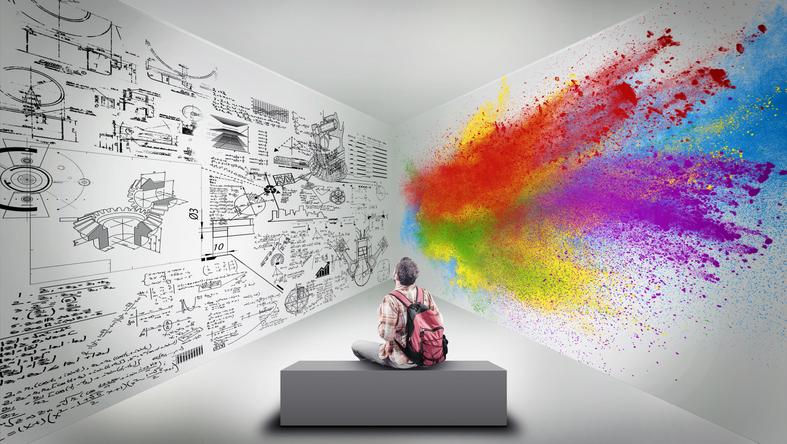
When we reason about a problem, we usually use a simple and useful scheme most of the time. This way of thinking is what is known as linear thinking.
Below we will see the details of this mental process to know the characteristics and types of linear thinking and to know when we usually resort to this model.
What is linear thinking?
Linear thinking, also called vertical thinking, is a problem-solving method that the human mind uses on a regular basis This way of facing the intellectual challenge requires several conditions.
First of all, of course, we must select the stimulus about which we are going to reason. In addition, we will be analytical regarding the variables of the problem in question. Finally, another of the fundamental characteristics of linear thinking is that it is sequential. This scheme is based on a conscious and rational approach to the stimulus being worked on.
The term linear or vertical thinking was coined by psychologist Edward de Bono in 1970, when he wrote about what would be the contrast to this concept, lateral thinking. We will talk about it later. In his publications, de Bono distinguishes between linear and critical thinking because, although they have similarities, linear thinking implies that the person uses the method to find a solution to the problem.
When we apply this way of reasoning, we automatically select the relevant information for the resolution process, ignoring everything that is not useful to us. The object is to find the answer that fits most satisfactorily, once the sequence of thought has been carried out and the problem has been analyzed.
What is the practical application of linear thinking? As many as we can imagine. It is evident that the possibilities of human thought are infinite, therefore, the application of one of its methods will also be infinite, by definition.
How to learn to use linear thinking
Author Paul Sloane developed a famous method so that children could develop and optimize their linear thinking This system is that of situational puzzles. It is a series of exercises in which a problem is always posed and then a series of solutions.
The point is that some of these solutions will be impossible, others will be possible and one in particular will be the most correct of all. They are all shown to the child and he must decide which one to choose. This exercise has a double function. On the one hand, the participant is developing the ability, not only in linear thinking but also in lateral
But in addition, the evaluator, who may be the teacher or another professional, can check in a graphic and simple way what type of thinking is predominant in the child. These tests are designed to be used with children from 4 years old, as this is the age at which they discover that not all thoughts are always true and when they begin to use induction in their reasoning.
Therefore, it is then that they are enabled to perform a sequential thought process, as required for linear thinking. According to Sloane, applying this type of exercises from an early age helps to mature thinking methods, It provides both emotional and social stability to the child, helps him reduce his aggressiveness and has a positive impact on his academic life
Types of linear thinking (and their characteristics)
We already know the characteristics of this mental process and the way in which it can be stimulated. Now we will try to discover the differences between the different types of linear thinking that we can find.
We have seen that all linear thinking requires an analysis process to then establish a series of steps in the procedure in which no error can be made. But within this framework, we find the following types.
1. Natural thinking
The first type of linear thinking that we are going to know is natural thinking. This way of reasoning is characterized by appearing spontaneously It is an impulsive way of thinking and therefore no type of operation is used during it.
2. Logical thinking
The next modality that we find is logical thinking. This form of linear thinking establishes a sequence of reasoning in which the individual faces disjunctive questions, in which he or she must respond affirmatively or negatively to each question that arises with the aim of finding a logical solution to the problem that has been posed.
3. Mathematical thinking
Finally, we have mathematical thinking. This It is a more complex form of linear thinking and, in contrast to natural thinking, it bases its entire operation on the use of mathematical elements such as rules, symbols and even different algorithms.
How to measure linear thinking
All the types of linear thinking that we have seen develop in human beings during the school stage, continuously, since it is the moment in which people learn to reason logically. Now… how do you research this kind of psychological processes?
Of course, not all people make the same use of linear thinking We have already commented on the existence of other modalities of reasoning, such as lateral thinking, for example. In order to evaluate the degree to which a person uses this way of thinking. Let’s review some of the tests that have been designed with this objective.
1. Myers-Briggs type indicator
The Myers-Briggs test, or MBTI, studies the way in which an individual receives stimuli from their environment and makes the relevant decisions based on it To achieve this objective, it uses four axes that are then combined with each other, giving rise to a grid with different possibilities that indicates in which of them exactly the subject who has performed the test is located.
The axes that the MBTI uses and through which we can infer the degree to which it uses linear thinking are, firstly, extraversion and introversion, then, intuition and sensation, thirdly, feeling and thinking, and finally, perceiving. or judge. The axis that would have the most weight for the question at hand is that of intuition-sensation. Subjects who score higher on sensation will be more likely to use vertical thinking.
2. Learning and thinking styles
Another very useful tool to evaluate the strength with which a person uses linear thinking is learning and thinking styles, also called SO-LAT. Through the results of said test, The evaluator can obtain information about whether the processes used by the subject are holistic or, on the contrary, analytical
It would be, in fact, the analytical type that would allow us to infer that the individual is more prone to using linear thought processes compared to other modalities.
3. Linear and non-linear thinking style profile
The tests we have seen so far serve to intuit in a certain way the use of linear thinking, but they are not tools designed expressly for this task. For this reason, a group of researchers, led by Charles Vance, decided in 2007 to create a test that would evaluate exactly this question. This is how they designed the LNTSP, or linear or nonlinear thinking style profile.
This tool It is a Likert scale questionnaire made up of 74 items thanks to which evaluators can obtain results that indicate the degree to which the subject is more inclined to use linear thinking or if, on the contrary, they have a greater tendency to take advantage of the resources offered by non-linear thinking, such as It’s the side.
Linear Thinking vs. Lateral Thinking
We have mentioned lateral thinking several times, which would be a different way of reasoning than that which characterizes linear thinking. Lateral thinking, on the contrary, introduces a creative component into the reasoning system that breaks with the rigidity of the scheme It is a way of thinking that is not always based on logic, but requires imagination and the creation of mental scenarios in search of a solution.
The term lateral thinking, like linear thinking, comes from the publications of the aforementioned author, Edward de Bono. It is a concept that has gained enormous popularity, although it has also received some criticism. Some of the detractors of this approach claim that it is not a scientific concept, but rather a pseudoscientific one.
In any case, it would be the other end of the continuum between linear and non-linear thinking, an axis in which all human beings move, although each one has a greater tendency to habitually place themselves at a specific point on said continuum.








